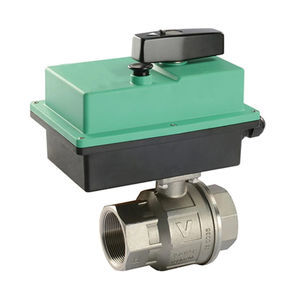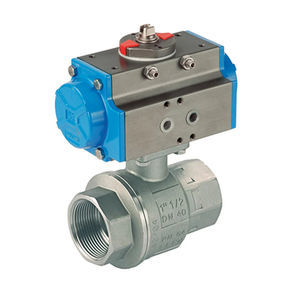
- Hydraulics - Pneumatics
- Valve
- Ball valve
- Riels Instruments
- Company
- Products
- Catalogs
- News & Trends
- Exhibitions
Ball valve SR pneumatically-operatedfor controlregulating


Add to favorites
Compare this product
Characteristics
- Type
- ball
- Operation
- pneumatically-operated
- Function
- for control, regulating
- Media
- for compressed air
- Body
- stainless steel
- Applications
- industrial, liquids, irrigation
- Number of channels
- 3-way
- Other characteristics
- electromagnetic
- DN
Min.: 0.375 in
Max.: 2 in
- Pressure
10 bar
(145 psi)- Temperature
Min.: -20 °C
(-4 °F)Max.: 150 °C
(302 °F)
Description
A liquid or gas solenoid valve is used to control the flow of liquids or gases in an industrial automation system, irrigation systems, cooling systems, process control applications and much more. It works thanks to the interaction of mechanical and electrical components.
Here's how it works in general:
Electromagnetic Coil: The solenoid valve has an electromagnetic coil wrapped around a ferromagnetic core. When an electrical voltage is applied to the coil, it generates a magnetic field around the core.
Armature or piston: Inside the solenoid valve, there is a component called an armature or piston, usually made of a ferromagnetic material. This armature is positioned so that it can move inside a chamber or tube that controls the flow of the liquid.
Return Spring: Often, there is also a return spring that pushes the armature or piston into a closed position when the coil is not energized.
Orifice or Valve: The orifice or valve is located within the liquid flow chamber. When the armature is in its rest position (when the coil is not energized), the orifice is closed, stopping the flow of liquid.
Electrical control: When voltage is applied to the electromagnetic coil, it creates a magnetic field that attracts the armature towards it, overcoming the force of the return spring. When the armature moves, the orifice opens, allowing liquid to flow through the valve.
Flow Control: The degree of opening of the orifice depends on the intensity of the electrical current supplied to the coil. The higher the current, the greater the magnetic attraction and the wider the orifice is open. In this way, the solenoid valve allows you to precisely regulate the flow of liquid.
Catalogs
No catalogs are available for this product.
See all of Riels Instruments‘s catalogsRelated Searches
- Valve
- Control valve
- Stainless steel valve
- Ball valve
- Pneumatic valve
- Electrically operated valve
- Regulating valve
- Electric valve
- Gas solenoid valve
- 2-way solenoid valve
- Pneumatically-operated valve
- Metal solenoid valve
- Nickel-plated brass valve
- Water solenoid valve
- Air solenoid valve
- 3-way valve
- Pilot-operated solenoid valve
- Stainless steel solenoid valve
- Air valve
- Brass solenoid valve
*Prices are pre-tax. They exclude delivery charges and customs duties and do not include additional charges for installation or activation options. Prices are indicative only and may vary by country, with changes to the cost of raw materials and exchange rates.



